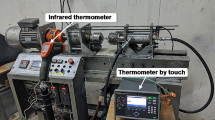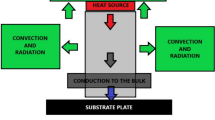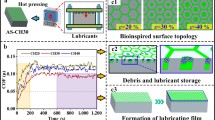Abstract
When welding high-strength steel and ultra-thin plates, traditional resistance spot welding has technical problems such as a narrow process window and difficulty in ensuring both welding strength and forming quality, making it one of the bottlenecks in the manufacture of high-end structural parts in the fields of vehicles, aviation, and aerospace. The core reason is that the traditional spot welding thermal cycle mode is single, the energy is highly concentrated, and the controllability is poor. Therefore, there is an inconsistency between its energy distribution and nugget quality. In view of the above difficulties, a new idea of resistance spot welding of special-shaped electrodes based on energy distribution design is proposed. By inlaying insulating ceramics and other materials on the electrode end face, a “composite annular electrode” is prepared to realize the regulation of energy distribution in the welding process. In this paper, experimental and numerical simulation are carried out to reveal the detailed influence of the diameter of the ceramic core on the joint forming and thermal distribution. The results show that the welding effect of composite annular electrodes is better than that of traditional electrodes under different thickness plates. The maximum strength of the joint can reach 2600 N. The maximum temperature during welding shall not exceed 1930 °C. And the optimal ceramic core diameter is optimized for ultra-thin plates and high-strength steel plates commonly used in automobiles.
















Similar content being viewed by others
Data availability
The datasets supporting the conclusions of this article are included within the article.
References
Yongbing Li, Yating Li, Ming L, Zhongqin L (2012) Lightweighting of car body and its challenges to joining technologies. J Mech Eng 48:44–54
Li Yongbing, Ma Yunwu, Lou Ming, Lei Haiyang, Lin Zhongqin (2016) Advances in welding and joining processes of multimaterial lightweight car body. J Mech Eng 52:1–23
Zhanxiang L, Zhen L, Yueqiao F, Sansan Ao (2017) A combination joining technology of spot welding and rive-ting for aluminum and steel. Trans China Weld Inst 38:101–104
Pouranvari M, Asgari HR, Mosavizadch SM, Marashi PH, Goodarzi M (2007) Effect of weld nugget size on overload failure mode of resistance spot welds. Sci Technol Weld Join 12:217–225
Qi S, Yongbing Li, Guanlong C, Zhongqin L (2011) Impact of external magnetic field generated by permanent magnet on quality of dualphase high strength steel by resistance spot welding. Trans China Weld Inst 32:21–24
Mathieu A, Shabadi R, Deschamps A, Suery M, Matteï S, Grevey D, Cicala E (2007) Dissimilar material joining using laser (aluminum to steel using zinc-based filler wire). Opt Laser Technol 39(3):652–661
Manladan SM, Yusof F, Ramesh S, Fadzil M (2016) A review on resistance spot welding of magnesium alloys. Int J Adv Manuf Technol 86:1805–1825
Qiu R, Iwamoto C, Satonaka S (2009) Interfacial microstructure and strength of steel/aluminum alloy joints welded by resistance spot welding with cover plate. J Mater Process Tech 209:4186–4193
Kim J, Kim I, Kim Y (2016) Optimization of welding current waveform for dissimilar material with DP590 and Al5052 by delta-spot welding process. J Mech Sci Technol 30:2713–2721
Li Y, Li D, Lin Z, David S, Feng Z, Tang W (2016) Review: magnetically assisted resistance spot welding. Sci Technol Weld Join 21:59–74
Haibo Li, Biao C (2013) Design and characteristics analysis of spot welding servo pressure device. Trans China Weld Inst 34:91–94
Ling Z, Li Y, Luo Z, Feng Y, Wang Z (2016) Resistance element welding of 6061 aluminum alloy to uncoated 22MnMoB boron steel. Mater Manuf Process 31:2174–2180
Ranfeng Q, Zhongbao S, Qingzhe Li, Hongxin S, Nannan W (2016) Resistance rivet-welding of aluminum alloy and steel. Trans China Weld Inst 37:39–42
Shumin Xu, Weijie Li, Xianglei L, Hejuan C (2021) Performance analysis of plastic deformation inertial control switch based on 3D printing. J Ordnance Equip Eng 42(05):244–249
Yanwu W, Fanhao Z, Kun Y, Chen He, Xinfa S (2022) Research on monitoring engine oil deterioration degree by thick film sensor. J Ordnance Equip Eng 43(04):179–183
Ren D, Zhao D, Zhao K, Liu L, He Z (2019) Resistance ceramic-filled annular welding of DP980 high-strength steel. Mater Des 183:108118
Ren D, Zhao D, Li C, Liu L, Zhao K (2019) Resistance ceramic-filled annular welding of thin steel sheets. J Manuf Process 45:588–594
Dewang Z, Daxin R, Gang S, Kunmin Z, Liming L, Zhaodong Z (2020) Comparison of mechanical properties and the nugget formation of composite ceramic-centered annular welding and traditional resistance spot welding. Int J Mech Sci 187(12):105933
Johnson GR, Cook WH (1985) Fracture characteristics of 3 metals subjected to various strains, strain rates, temperatures and pressures. Eng Fract Mech 21(1):31–48
Sung JH, Kim JN, Wagoner RH (Dec2010) A plastic constitutive equation incorporating strain, strain-rate, and temperature. Int J Plast 26(12):1746–1771
Choi SH, Kim EY, Woo W, Han SH, Kwak JH (Jun2013) The effect of crystallographic orientation on the micromechanical deformation and failure behaviors of DP980 steel during uniaxial tension. Int J Plast 45:85–102
Cheng G, Hu XH, Choi KS, Sun X (Oct2017) Predicting grid-size-dependent fracture strains of DP980 with a microstructure-based post-necking model. Int J Fract 207(2):211–227
Umbrello D, M’Saoubi R, Outeiro JC (Mar2007) The influence of Johnson-Cook material constants on finite element simulation of machining of AISI 316L steel. Int J Mach Tools Manuf 47(3–4):462–470
Samantaray D, Mandal S, Bhaduri AK (Dec2009) A comparative study on Johnson Cook, modified Zerilli-Armstrong and Arrhenius-type constitutive models to predict elevated temperature flow behaviour in modified 9Cr-1Mo steel. Comput Mater Sci 47(2):568–576
Raoelison RN, Fuentes A, Pouvreau C, Rogeon P, Carre P, Dechalotte F (2014) Modeling and numerical simulation of the resistance spot welding of zinc coated steel sheets using rounded tip electrode: analysis of required conditions. Appl Math Model 38(9–10):2505–2521
De A, Thaddeus MP, Dorn L (2003) Numerical modelling of resistance spot welding of aluminium alloy. ISIJ Int 43(2):238–244
Khan JA, Xu LJ, Chao YJ, Broach K (Apr2000) Numerical simulation of resistance spot welding process. Numer Heat Transf Part A-Appl 37(5):425–446
Khan JA, Broach K, Kabir A (2000) Numerical thermal model of resistance spot welding in aluminum. J Thermophys Heat Transf 14(1):88–95
Bay N, Wanheim T (1976) Real area of contact and friction stress at high-pressure sliding contact. Wear 38(2):201–209
Funding
This research is financially supported by the Anhui University Natural Science Fund project(KJ2021A0417), the High-level Scientific Research Startup Fund for the Introduction of Talent of Anhui University of Science and Technology, the National Natural Science Foundation of China (51775160), and the China Postdoctoral Science Foundation (2020M680947).
Author information
Authors and Affiliations
Contributions
The author contributions are as follows: Dewang Zhao and Kunmin Zhao were in charge of the whole trial; Dewang Zhao and Chao Zhang wrote the manuscript; Daxin Ren assisted with experimentation; Dewang Zhao and Daxin Ren assisted with FEM. All authors read and approved the final manuscript.
Corresponding author
Ethics declarations
Competing interests
The authors declare no competing interests.
Additional information
Publisher's note
Springer Nature remains neutral with regard to jurisdictional claims in published maps and institutional affiliations.
Rights and permissions
Springer Nature or its licensor (e.g. a society or other partner) holds exclusive rights to this article under a publishing agreement with the author(s) or other rightsholder(s); author self-archiving of the accepted manuscript version of this article is solely governed by the terms of such publishing agreement and applicable law.
About this article
Cite this article
Dewang, Z., Chao, Z., Daxin, R. et al. Experimental and numerical simulation on forming and thermal distribution of a new composite annular electrode joint. Int J Adv Manuf Technol 125, 213–229 (2023). https://doi.org/10.1007/s00170-022-10690-6
Received:
Accepted:
Published:
Issue Date:
DOI: https://doi.org/10.1007/s00170-022-10690-6




